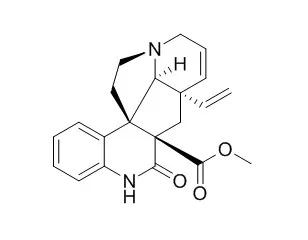| Structure Identification: |
| J Nat Prod. 2013 Dec 27;76(12):2322-9. | | Melosuavines A-H, cytotoxic bisindole alkaloid derivatives from Melodinus suaveolens.[Pubmed: 24274642] |
METHODS AND RESULTS:
Eight new bisindole alkaloids, melosuavines A-C (1-3), having an aspidosperma-Scandine linkage, melosuavines D-F (4-6), possessing an aspidosperma-aspidosperma skeleton, and melosuavines G and H (7 and 8) of the aspidosperma-venalatonine type, tenuicausine (9), and melodinine J (10) were isolated from the twigs and leaves of Melodinus suaveolens. The structures of 1-8 were elucidated by extensive spectroscopic methods, and compounds 9 and 10 were identified by comparison with data in the literature. The relative configuration 9 was determined from the ROESY spectrum, and some NMR signals were reassigned.
CONCLUSIONS:
Compounds 1, 2, 4-6, 8, and 10 exhibited low micromolar cytotoxicity against one or more of five human cancer cell lines. | | J Org Chem. 2014 Apr 4;79(7):3173-84. | | Intramolecular cycloaddition reactions of furo[3,4-b]indoles for alkaloid synthesis.[Pubmed: 24617539] | Model studies dealing with the Cu(II)- or Rh(II)-catalyzed carbenoid cyclization/cycloaddition cascade of several α-diazo indolo amido esters have been carried out as an approach to the alkaloid Scandine.
METHODS AND RESULTS:
The Cu(II)-catalyzed reaction of an α-diazo indolo diester that contains a tethered oxa-pentenyl side chain was found to give rise to a reactive benzo[c]furan which undergoes a subsequent [4 + 2]-cycloaddition across the tethered π-bond. The reaction proceeds by the initial generation of a copper carbenoid intermediate which cyclizes onto the adjacent carbonyl group to give a reactive benzo[c]furan which in certain cases can be isolated. Disappointingly, the analogous reaction with the related amido indolo ester failed to take place, even when the tethered π-bond contained an electron-withdrawing carbomethoxy group.
CONCLUSIONS:
It would seem that the geometric requirements for the intramolecular cycloaddition of the furo[3,4-b]indole system with the tethered π-bond imposes distinct restrictions upon the bond angles of the reacting centers to prevent the cycloaddition reaction from occurring. However, the incorporation of another carbonyl group on the nitrogen atom of the tethered alkenyl diazo amido indolo ester seemingly provides better orbital overlap between the reacting π-systems and allows the desired cycloaddition reaction to occur. | | Beilstein J Org Chem. 2012;8:107-11. | | Synthesis of fused tricyclic amines unsubstituted at the ring-junction positions by a cascade condensation, cyclization, cycloaddition then decarbonylation strategy.[Pubmed: 22423277] |
METHODS AND RESULTS:
Heating aldehydes that contain a protected hydroxymethyl group, a tethered alkyl chloride and a tethered alkenyl group at the α-position of the aldehyde with an amine sets up a cascade (tandem) reaction sequence involving condensation to an intermediate imine, then cyclization and formation of an intermediate azomethine ylide and then intramolecular dipolar cycloaddition. The fused tricyclic products are formed with complete or very high stereochemical control.
CONCLUSIONS:
The hydroxymethyl group was converted into an aldehyde - which could be removed to give the tricyclic amine products that are unsubstituted at the ring junction positions - or was converted into an alkene, which allowed the formation of the core ring system of the alkaloids Scandine and meloscine. |
|






 Cell. 2018 Jan 11;172(1-2):249-261.e12. doi: 10.1016/j.cell.2017.12.019.IF=36.216(2019)
Cell. 2018 Jan 11;172(1-2):249-261.e12. doi: 10.1016/j.cell.2017.12.019.IF=36.216(2019) Cell Metab. 2020 Mar 3;31(3):534-548.e5. doi: 10.1016/j.cmet.2020.01.002.IF=22.415(2019)
Cell Metab. 2020 Mar 3;31(3):534-548.e5. doi: 10.1016/j.cmet.2020.01.002.IF=22.415(2019) Mol Cell. 2017 Nov 16;68(4):673-685.e6. doi: 10.1016/j.molcel.2017.10.022.IF=14.548(2019)
Mol Cell. 2017 Nov 16;68(4):673-685.e6. doi: 10.1016/j.molcel.2017.10.022.IF=14.548(2019)